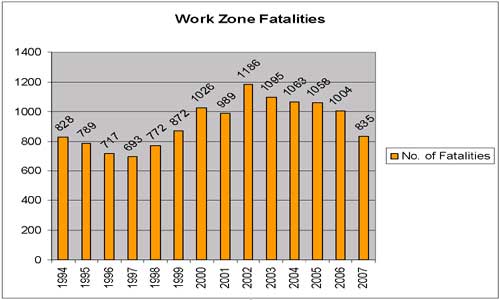|
Economic Recovery Home > Work Zone Considerations
Note: Updated 3/20/09
Work Zone Considerations for Economic Recovery Projects
It has been estimated that work zones on freeways account for nearly 24 percent of non-recurring delay, and 10 percent of overall delay. In addition, the number of people killed as a result of crashes in work zones remains significant (835 in 2007).

Safety and mobility impacts from work zones will likely be magnified with the infusion of a large number of new projects under the Economic Recovery initiative. Appropriate planning, coordination, sequencing, and scheduling of projects will be critical in order to minimize conflicts and delays, and maintain an acceptable level of mobility and safety during construction. The cumulative effect of projects in close proximity will need to be assessed and managed to minimize potential impacts.
Related Regulations and Guidance:
The Work Zone Safety and Mobility Rule (23 CFR 630 Subpart J) established a framework for the comprehensive consideration of the safety and mobility impacts of work zones across project development stages, and the adoption of strategies that help manage these impacts during project implementation. The Rule expands thinking beyond the project limits to address corridor, network, and regional issues while planning and designing road projects. Additional information on the Rule and guidance on a number of related topics including Work Zone Impacts Assessment; Developing and Implementing Transportation Management Plans; and Work Zone Public Information and Outreach can be found at http://ops.fhwa.dot.gov/wz/resources/final_rule.htm.
Information and guidance on additional regulations that supplement/complement the Work Zone Safety and Mobility Rule to further emphasize specific safety considerations can be found at http://ops.fhwa.dot.gov/wz/resources/policy.htm. These include the Temporary Traffic Control Devices Rule (23 CFR 630 Subpart K), and the Worker Visibility Rule, both of which became effective toward the end of 2008.
Work Zone Traffic Analysis:
In order to meet safety and mobility needs during highway maintenance and construction, and to meet the expectations of the traveling public, it is important to systematically analyze and assess the work zone impacts of projects and take appropriate action to manage these impacts. Additional information on resources and tools can found at http://ops.fhwa.dot.gov/wz/traffic_analysis/.
Work Zone Strategies:
Managing traffic during construction is necessary to minimize traffic delays, maintain or improve motorist and worker safety, complete roadwork in a timely manner, and maintain access for businesses and residents. Information on work zone traffic management strategies can be found at http://www.ops.fhwa.dot.gov/wz/traffic_mgmt/. Some specific strategies include:
Among the large variety of work zone strategies are some that can help expedite project completion:
Best Practices:
A broad variety of work zone best practices in areas such as prediction, modeling and impact assessment, planning and programming, contracting and bidding procedures, project design, public relations/outreach, and many others are available at http://ops.fhwa.dot.gov/wz/practices/practices.htm.
Some best practices relating to the coordination of multiple projects can be found at http://ops.fhwa.dot.gov/wz/practices/best/topindex.asp?id=107.
Training:
A variety of work zone related training, guidance and software have been developed under the Work Zone Safety Program. Information on these, and other work zone related training available, including those from the National Highway Institute, can be found at http://ops.fhwa.dot.gov/wz/outreach/outreach.htm.
Technical Assistance:
A Work Zone Peer-to-Peer Program is available that serves as a resource to agencies looking for better methods, tools and strategies to improve work zone safety and mobility. Through this program, assistance is available from experienced practitioners who have “been there and done that” and have lessons learned and success stories that they can share to help others as they contemplate different ways to address work zone safety and mobility. Information on this program, including how to take advantage of it, can be found at http://ops.fhwa.dot.gov/wz/outreach/outreach.htm.
Other Resources:
The National Work Zone Safety Information Clearinghouse provides a comprehensive work zone information resource that can be accessed at http://www.workzonesafety.org/. In addition to information on a broad variety of work zone training, the Clearinghouse also includes information on a variety of safety technologies and techniques that should be considered for work zones as appropriate, including: traditional law enforcement, automated speed enforcement, variable speed limit systems, service patrols, dynamic message signs, "back-of-queue" detection, nighttime construction, public information campaigns, and the proper design and installation of temporary traffic control devices.
|